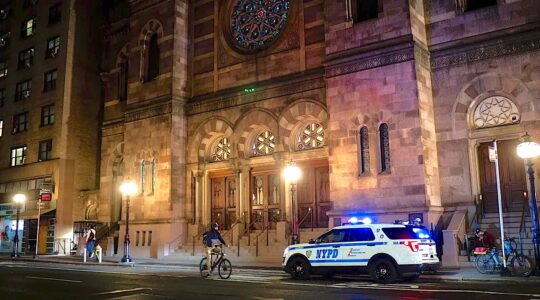At the Janowska concentration camp outside of Lvov in what is now Ukraine, Zeev Porath, who had studied architecture, worked as a slave laborer in a drafting studio. From the window, he witnessed women prisoners being undressed, tortured and killed by the Nazis, and secretly drew the scene. In 1943, he escaped from the camp and eventually made his way to Israel, saving the drawing. For the first time, the skillful line drawing, “Tortures,” is on view in the United States, on loan from the Ghetto Fighters’ House in Israel.
The piece is featured in a groundbreaking multimedia show running through May 12 at the Ronald Feldman Gallery in Soho (feldmangallery.com) “Violated! Women in Holocaust and Genocide” features the work of more than 30 artists, including Holocaust survivors, their close relatives, witnesses and others concerned with the issues, including Judy Chicago and Donald Woodman, Muriel (Nexhnie) Helfman, Shosh Kormosh, Nancy Spero and Linda Stein. Many of the works reflect on the little-discussed subject of sexual violence during the Holocaust, while others address genocide and ethnic cleansing in Bosnia, Darfur, Eritrea, Guatemala, Iraq and Nigeria.
There are naked bodies, expressions of terror, hair and all its suggestiveness about the humiliations women suffered. This is art that can be difficult to encounter; the subjects are dark and speak of tragedy. But the viewer also sees moments of beauty, like a bird on a shoulder, and the resiliency of the women and the resourcefulness of the artists who bring forward the truth.
Art is “another way of calling attention to issues that need calling attention to.
Rochelle Saidel, exhibition coordinator and founder and executive director of Remember the Women Institute, has written extensively about the Holocaust, and is the author of the book “Sexual Violence Against Jewish Women During the Holocaust.” In an interview, she says that art is “another way of calling attention to issues that need calling attention to.”
She worked with curator Batya Brutin, an art historian and author who specializes in visual art dealing with the Holocaust. As Saidel explains, it was gallery owner Feldman who suggested that they bring the show up to the present by including art depicting more recent examples of genocide.
Saidel says that they don’t mean to equate the different genocides in any way, but to show parallels of terror and powerlessness.
“The horror on women’s faces is the same.”
When Saidel began doing research about Ravensbruck women’s concentration camp in the 1980s, she thought that sexual violence against women was a rare occurrence during the Holocaust. But, now, she has changed her mind completely — she writes in the exhibition catalog that “in one form or another, to one degree or another, most women must have suffered from some sort of sexual abuse in the Holocaust — from humiliation to outright rape.”
“We want to be educating for the present and the future. I don’t know if it’s possible, but we hope in some way to contribute to stopping the horror, which is still going on.”
She recognizes that there’s no way to document these cases, and no statistical studies exist.
“The Nazis were meticulous record keepers, but there was no such thing as a rape certificate. And murdering a rape victim was all too easy. However, the available testimonies by victims and witnesses, a better understanding of sexual violence and victims’ reluctance to speak, new research, and experience ‘reading between the lines’ of the unspoken are enough to convince me.”
Nechama Golan, the daughter of a Holocaust survivor, presents an empty, shapeless striped dress hanging on a wall; it deals with, as she says in an artist statement, “the imprisonment, degradation, and negation of womanhood.”
Israeli artist Gil Yefman’s sculptural piece “Sex Slaves” refers to Nazi brothels set up in the concentration camps. He works with knit and crocheted materials, which remind him of the act of writing — a narrative is created through syllables, or stitches. His life-size crocheted doll represents a woman who has been violated.
Support the New York Jewish Week
Our nonprofit newsroom depends on readers like you. Make a donation now to support independent Jewish journalism in New York.
The only piece commissioned especially for the show is a collaborative effort between Yefman and the Kuchinate Collective of African Women Refugees in Tel Aviv. Yefman worked with the women who regularly crochet beautiful baskets, this time making them life-sized, weaving in their personal stories of abuse and sharing their pain.
“We want to be educating for the present and the future,” Saidel says. “I don’t know if it’s possible, but we hope in some way to contribute to stopping the horror, which is still going on.”
The New York Jewish Week brings you the stories behind the headlines, keeping you connected to Jewish life in New York. Help sustain the reporting you trust by donating today.




